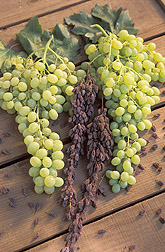This page has been archived and is being provided for reference purposes only. The page is no longer being updated, and therefore, links on the page may be invalid.
|
Read the magazine story to find out more. |
Vineyard Research Yields Yummy RaisinsBy Marcia WoodDecember 20, 2002 Some of your favorite holiday cookies or other treats might be made with plump, juicy raisins. More than half of the world's raisins come from the San Joaquin Valley in central California. Scientists at the ARS San Joaquin Valley Agricultural Sciences Center have recently developed two kinds of appetizing raisins for growing in this region. ARS horticulturist David W. Ramming and technician Ronald E. Tarailo at Parlier--where the center is headquartered--bred the raisin grapes, known as Selma Pete and Diamond Muscat. Selma Pete raisins can dry on the vine after the canes that bear the grapes are cut. This feature makes them ideal for mechanical harvesting and thus cuts costs. Ramming named Selma Pete after longtime collaborator L. Peter Christensen, who is now retired from the University of California's Cooperative Extension Service. Selma Pete raisins ripen early. That trait reduces the chance that the crop could be damaged by unseasonably early rains in the fall. Earliness is also a prized trait of Diamond Muscat. This grape provides an important alternative to Muscat of Alexandria, the muscat most commonly used to make dessert wines or confections such as chocolate-covered raisins. Diamond Muscat is seedless, giving it a key advantage over Muscat of Alexandria. When the seeds are removed mechanically from Muscat of Alexandria raisins, sticky, damaged fruit may result. Ramming and Tarailo made Diamond Muscat and Selma Pete available to growers and nurseries. This came after a decade of research--during which they inspected more than 400 experimental vines of each variety and sampled some of the 24,000 pounds of fresh raisins from these vines. Both raisin grapes are descendants of parent vines developed in the early 1900s by USDA scientists in California. Besides being fun to eat, raisins are good for you. They contain no fat and provide fiber, potassium and iron. The raisin grapes are featured in the December issue of Agricultural Research. ARS is the U.S. Department of Agriculture's chief scientific research agency. |

